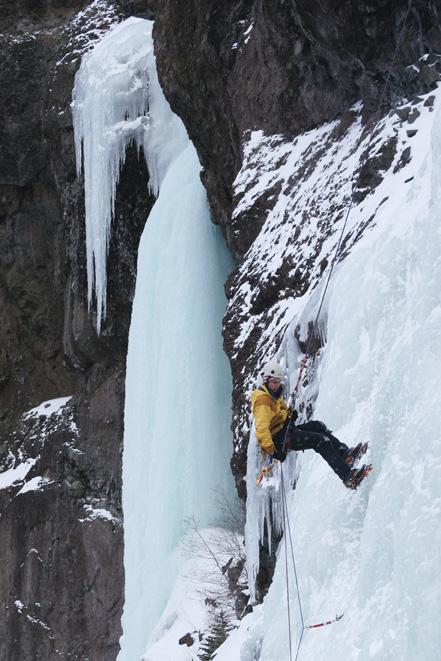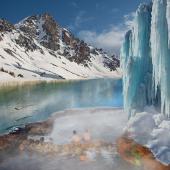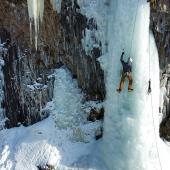Frozen Fun
Once the domain of hardened alpinists, ice climbing has come a long way in its evolution and now anyone (thanks largely to modern equipment and Gallatin County snowplows) can enjoy a sense of adventure, complete with warming afternoon sun and hot cocoa between rounds on the vertical. Here are a few quick pointers to accelerate your learning curve.
Efficiency First
Commonly mistaken for a brute sport, ice climbing is actually an endurance event. Don’t waste energy trying to climb hand-over-hand like Stallone in Cliffhanger; pushing up with your feet will gain elevation far more easily.
Love Triangles
Well-known for their inherent stability, triangle shapes can be applied to your posture to ease progression. After placing one tool overhead, move your feet in baby steps to the same height as one another, just past shoulder-width apart, and center your body beneath said tool. The three points of contact should form a perfect triangle, providing a stable base to work from. Place the second tool overhead and repeat, with your hips tucked in toward the ice while you swing and your butt sticking out as you move your feet. You’ll move from one restful stance to the next.
Aim for the Concave
Concave ice is far less likely to explode than convex ice. Remember the surface tension experiment from elementary science class, with the over-filled glass of water? Same thing, but much more dramatic. Take advantage of other features in the ice, too. Often, you will find natural footholds; combine these with a light kick of your crampons, and then hold your foot still. Keeping your heels low will save strain on your calves and help to maintain a stable stance.
Be Nice to the Ice
That all sounds good, but it still looks crazy, right? It’s all relative—there are dangerous ice climbs and there are dangerous rock climbs. The trick is being able to recognize the difference. Ice climbing, much like skiing, is all about understanding the medium. Just as different snow conditions demand different techniques and differing degrees of snowpack instability afford greater or lesser risk, frozen waterfalls offer a broad range of conditions as well, from friendly, sun-warmed “thunker” ice that behaves like soft plastic, to cold, brittle sheets that shatter and fall with the slightest provocation.
Climbers’ Ed
If you’re bold and confident with a background in rock climbing and proficiency with protective systems, grab a copy of the local guidebook Winter Dance by Joe Josephson, rent some boots, tools, and crampons from either Northern Lights Trading Company or Prolite Gear, and give it a whack on your own—just be mindful of the new medium and the dramatic increase in falling debris or countless other complications beyond your basic afternoon on rock. Dress in warm, synthetic clothing similar to what you would wear for a day of skiing, perhaps a touch lighter, add a big puffy coat for when you’re not active, and bring a stack of gloves to rotate in case they get wet.
Prolite Gear (prolitegear.com) offers demo gear and rigs a variety of top-rope climbs, free of charge, every Wednesday evening throughout the season. Montana Alpine Guides (adventuremontana.com) and Montana Mountaineering Association (montanamountaineering.org) offer private guiding and instruction with highly experienced and professional staff.
Pete Tapley has ridden flying icicles and scaled mountains from Alaska to South America for the last twenty years. You can reach him for private instruction or guided climbs and follow his adventures online at petetapley.blogspot.com.












